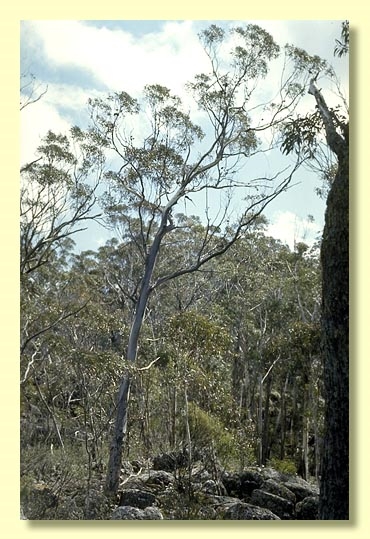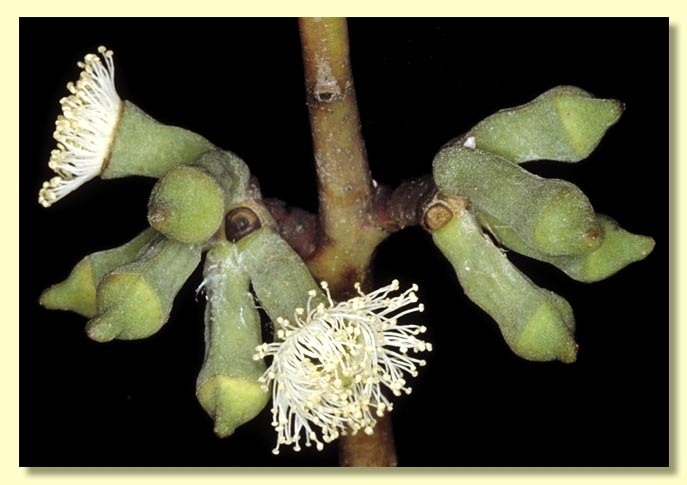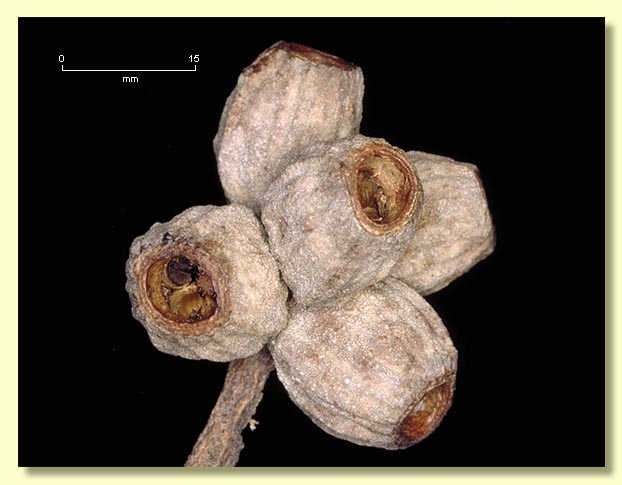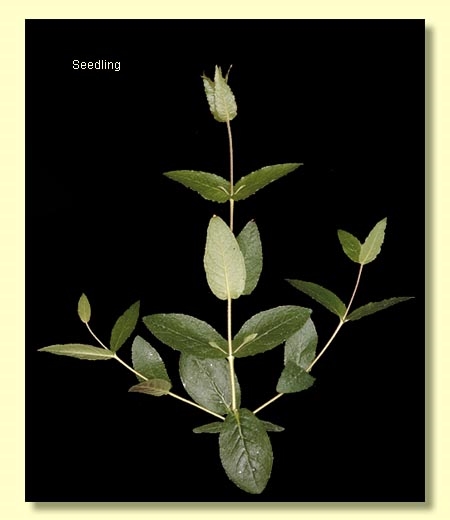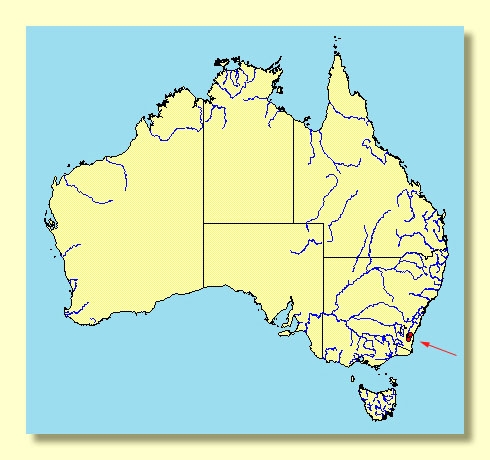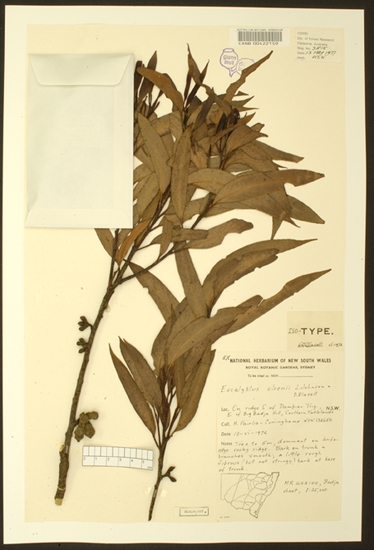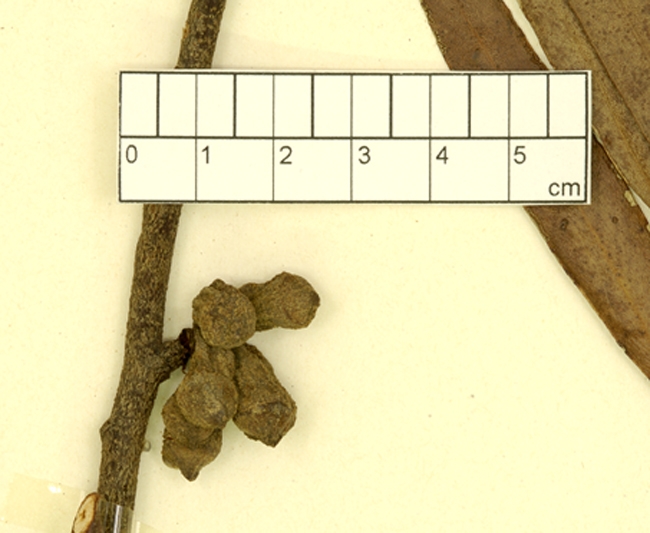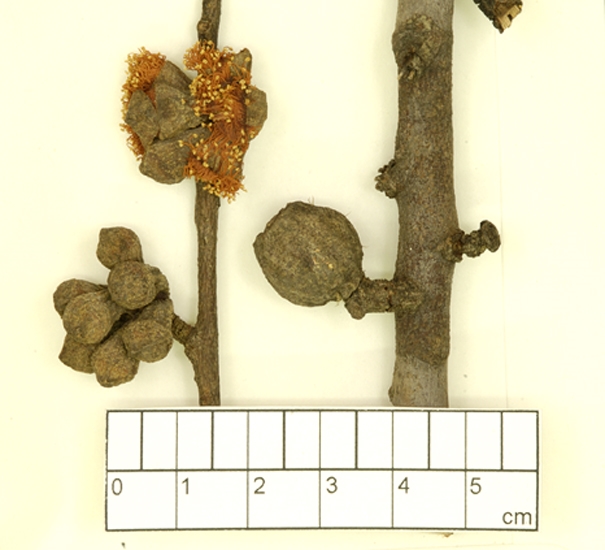Euclid - Online edition
Eucalyptus olsenii
Eucalyptus | Eucalyptus | Nebulosa
Bark rough only on lower trunk, fibrous or flaky, grey or grey-brown; smooth bark white, cream or grey, often with ribbons of decorticated bark in the upper branches.
Juvenile growth (coppice or field seedlings to 50 cm): stem rounded in cross-section, scabrid; juvenile leaves opposite and sessile for 6–10 nodes then becoming alternate, petiolate, ovate to lanceolate to elliptical, 3–7.5 cm long, 1.2–4 cm wide, discolorous, glossy, green; scabrid on stems and leaves for early leaf pairs but this is lost at or soon after alternation.
Adult leaves alternate, petiole 0.5–1.5 cm long; blade lanceolate to falcate, 5–12 cm long, 1–2 cm wide, base usually oblique, margin entire, concolorous, glossy, green, side-veins acute, reticulation obscure or sparse, intramarginal vein parallel to and just within margin, oil glands very numerous, mostly island.
Inflorescence axillary unbranched, peduncle erect or rigidly downturned, 0.3–0.8 cm long, buds 7 per umbel, pedicels 0–0.4 cm long. Mature buds obovoid, 1–1.7 cm long, 0.6–0.7 cm wide, scaly or scurfy, with obvious longitudinal ribs or ridges, scar absent, operculum conical to beaked, stamens irregularly flexed, anthers reniform to cordate, versatile, dorsifixed, dehiscing by confluent slits, style long, stigma tapered, locules 3 or 4, the placentae each with 2 vertical ovule rows. Flowers white.
Fruit sessile or with pedicels to 0.4 cm long, barrel-shaped or urceolate, 1.2–2.2 cm long, 1.2–1.8 cm wide, ribbed longitudinally, disc descending, valves 3 or 4, enclosed.
Seeds dark brown, 2–2.5 mm long, pyramidal or obliquely pyramidal, dorsal surface smooth, hilum terminal.
Cultivated seedlings (measured at ca node 10): cotyledons reniform; stems rounded in cross-section, stellate-hairy; leaves sessile and opposite for at least 10 nodes, ovate to lanceolate, 4–7.5 cm long, 1.5–4 cm wide, amplexicaul or the base rounded, margin irregular, apex pointed, discolorous, glossy, mid-green above, paler beneath.
Flowering has been recorded in October and November.
A small tree with a scattered distribution in high, steep, rocky mountain country on the eastern edge of the Southern Tablelands of New South Wales south of Braidwood, in an area roughly bounded by four mountains, viz. Dampier, Mother Woila, The Scout and Tabletop. Eucalyptus olsenii has some basal fibrous bark but is otherwise smooth-barked and has a glossy green crown. Its closest affinities within Eucalyptus subgenus Eucalyptus are not clear although the hairy seedlings suggest some affinity with the stringybark group. With the rigidly deflexed, seven-budded inflorescences and relatively large, tightly clustered ribbed fruit, it could not be confused with any other species in the area.
In the classification of Brooker (2000) Eucalyptus olsenii has an isolated taxonomic position in Eucalyptus subgenus Eucalyptus section Nebulosa because of an unusual combination of characters: small tree habit, thin fibrous rough bark only on lower trunk, shortly emergent oil glands with obvious radiating hairs on stems and lower leaves of seedlings and juvenile growth, axillary inflorescences with elongated buds having only one operculum and reniform anthers, ovules in two rows, fruit large, barrel-shaped, ribbed and with enclosed valves, and more or less pyramidal seeds.

